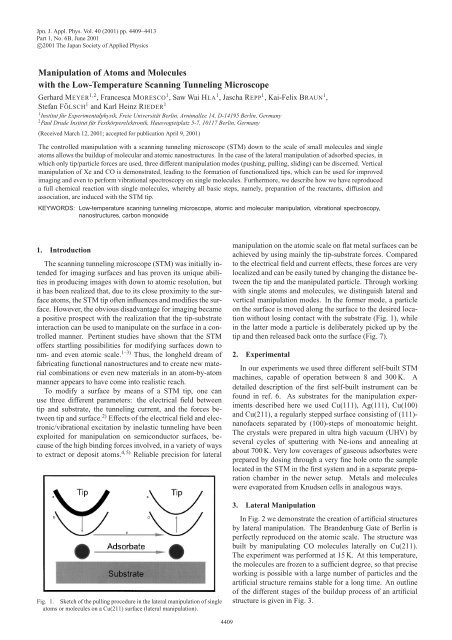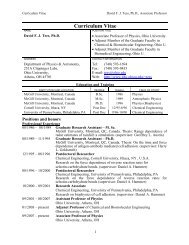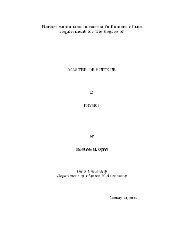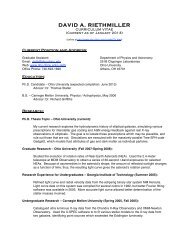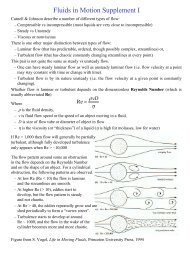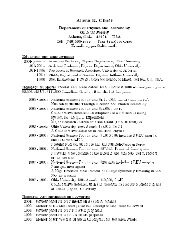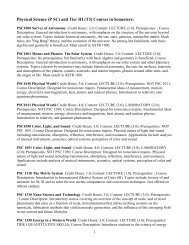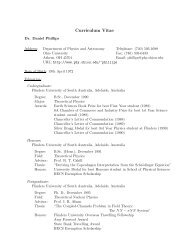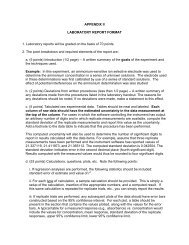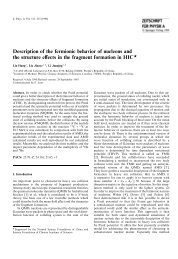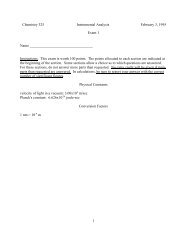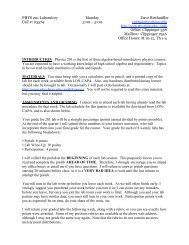Manipulation of Atoms and Molecules with the Low-Temperature ...
Manipulation of Atoms and Molecules with the Low-Temperature ...
Manipulation of Atoms and Molecules with the Low-Temperature ...
You also want an ePaper? Increase the reach of your titles
YUMPU automatically turns print PDFs into web optimized ePapers that Google loves.
Jpn. J. Appl. Phys. Vol. 40 (2001) pp. 4409–4413<br />
Part 1, No. 6B, June 2001<br />
c○2001 The Japan Society <strong>of</strong> Applied Physics<br />
<strong>Manipulation</strong> <strong>of</strong> <strong>Atoms</strong> <strong>and</strong> <strong>Molecules</strong><br />
<strong>with</strong> <strong>the</strong> <strong>Low</strong>-<strong>Temperature</strong> Scanning Tunneling Microscope<br />
Gerhard MEYER 1,2 , Francesca MORESCO 1 , Saw Wai HLA 1 , Jascha REPP 1 , Kai-Felix BRAUN 1 ,<br />
Stefan FÖLSCH 1 <strong>and</strong> Karl Heinz RIEDER 1<br />
1 Institut für Experimentalphysik, Freie Universität Berlin, Arnimallee 14, D-14195 Berlin, Germany<br />
2 Paul Drude Institut für Festkörperelektronik, Hausvogteiplatz 5-7, 10117 Berlin, Germany<br />
(Received March 12, 2001; accepted for publication April 9, 2001)<br />
The controlled manipulation <strong>with</strong> a scanning tunneling microscope (STM) down to <strong>the</strong> scale <strong>of</strong> small molecules <strong>and</strong> single<br />
atoms allows <strong>the</strong> buildup <strong>of</strong> molecular <strong>and</strong> atomic nanostructures. In <strong>the</strong> case <strong>of</strong> <strong>the</strong> lateral manipulation <strong>of</strong> adsorbed species, in<br />
which only tip/particle forces are used, three different manipulation modes (pushing, pulling, sliding) can be discerned. Vertical<br />
manipulation <strong>of</strong> Xe <strong>and</strong> CO is demonstrated, leading to <strong>the</strong> formation <strong>of</strong> functionalized tips, which can be used for improved<br />
imaging <strong>and</strong> even to perform vibrational spectroscopy on single molecules. Fur<strong>the</strong>rmore, we describe how we have reproduced<br />
a full chemical reaction <strong>with</strong> single molecules, whereby all basic steps, namely, preparation <strong>of</strong> <strong>the</strong> reactants, diffusion <strong>and</strong><br />
association, are induced <strong>with</strong> <strong>the</strong> STM tip.<br />
KEYWORDS: <strong>Low</strong>-temperature scanning tunneling microscope, atomic <strong>and</strong> molecular manipulation, vibrational spectroscopy,<br />
nanostructures, carbon monoxide<br />
1. Introduction<br />
The scanning tunneling microscope (STM) was initially intended<br />
for imaging surfaces <strong>and</strong> has proven its unique abilities<br />
in producing images <strong>with</strong> down to atomic resolution, but<br />
it has been realized that, due to its close proximity to <strong>the</strong> surface<br />
atoms, <strong>the</strong> STM tip <strong>of</strong>ten influences <strong>and</strong> modifies <strong>the</strong> surface.<br />
However, <strong>the</strong> obvious disadvantage for imaging became<br />
a positive prospect <strong>with</strong> <strong>the</strong> realization that <strong>the</strong> tip-substrate<br />
interaction can be used to manipulate on <strong>the</strong> surface in a controlled<br />
manner. Pertinent studies have shown that <strong>the</strong> STM<br />
<strong>of</strong>fers startling possibilities for modifying surfaces down to<br />
nm- <strong>and</strong> even atomic scale. 1–3) Thus, <strong>the</strong> longheld dream <strong>of</strong><br />
fabricating functional nanostructures <strong>and</strong> to create new material<br />
combinations or even new materials in an atom-by-atom<br />
manner appears to have come into realistic reach.<br />
To modify a surface by means <strong>of</strong> a STM tip, one can<br />
use three different parameters: <strong>the</strong> electrical field between<br />
tip <strong>and</strong> substrate, <strong>the</strong> tunneling current, <strong>and</strong> <strong>the</strong> forces between<br />
tip <strong>and</strong> surface. 2) Effects <strong>of</strong> <strong>the</strong> electrical field <strong>and</strong> electronic/vibrational<br />
excitation by inelastic tunneling have been<br />
exploited for manipulation on semiconductor surfaces, because<br />
<strong>of</strong> <strong>the</strong> high binding forces involved, in a variety <strong>of</strong> ways<br />
to extract or deposit atoms. 4, 5) Reliable precision for lateral<br />
Fig. 1. Sketch <strong>of</strong> <strong>the</strong> pulling procedure in <strong>the</strong> lateral manipulation <strong>of</strong> single<br />
atoms or molecules on a Cu(211) surface (lateral manipulation).<br />
manipulation on <strong>the</strong> atomic scale on flat metal surfaces can be<br />
achieved by using mainly <strong>the</strong> tip-substrate forces. Compared<br />
to <strong>the</strong> electrical field <strong>and</strong> current effects, <strong>the</strong>se forces are very<br />
localized <strong>and</strong> can be easily tuned by changing <strong>the</strong> distance between<br />
<strong>the</strong> tip <strong>and</strong> <strong>the</strong> manipulated particle. Through working<br />
<strong>with</strong> single atoms <strong>and</strong> molecules, we distinguish lateral <strong>and</strong><br />
vertical manipulation modes. In <strong>the</strong> former mode, a particle<br />
on <strong>the</strong> surface is moved along <strong>the</strong> surface to <strong>the</strong> desired location<br />
<strong>with</strong>out losing contact <strong>with</strong> <strong>the</strong> substrate (Fig. 1), while<br />
in <strong>the</strong> latter mode a particle is deliberately picked up by <strong>the</strong><br />
tip <strong>and</strong> <strong>the</strong>n released back onto <strong>the</strong> surface (Fig. 7).<br />
2. Experimental<br />
In our experiments we used three different self-built STM<br />
machines, capable <strong>of</strong> operation between 8 <strong>and</strong> 300 K. A<br />
detailed description <strong>of</strong> <strong>the</strong> first self-built instrument can be<br />
found in ref. 6. As substrates for <strong>the</strong> manipulation experiments<br />
described here we used Cu(111), Ag(111), Cu(100)<br />
<strong>and</strong> Cu(211), a regularly stepped surface consisting <strong>of</strong> (111)-<br />
nan<strong>of</strong>acets separated by (100)-steps <strong>of</strong> monoatomic height.<br />
The crystals were prepared in ultra high vacuum (UHV) by<br />
several cycles <strong>of</strong> sputtering <strong>with</strong> Ne-ions <strong>and</strong> annealing at<br />
about 700 K. Very low coverages <strong>of</strong> gaseous adsorbates were<br />
prepared by dosing through a very fine hole onto <strong>the</strong> sample<br />
located in <strong>the</strong> STM in <strong>the</strong> first system <strong>and</strong> in a separate preparation<br />
chamber in <strong>the</strong> newer setup. Metals <strong>and</strong> molecules<br />
were evaporated from Knudsen cells in analogous ways.<br />
3. Lateral <strong>Manipulation</strong><br />
In Fig. 2 we demonstrate <strong>the</strong> creation <strong>of</strong> artificial structures<br />
by lateral manipulation. The Br<strong>and</strong>enburg Gate <strong>of</strong> Berlin is<br />
perfectly reproduced on <strong>the</strong> atomic scale. The structure was<br />
built by manipulating CO molecules laterally on Cu(211).<br />
The experiment was performed at 15 K. At this temperature,<br />
<strong>the</strong> molecules are frozen to a sufficient degree, so that precise<br />
working is possible <strong>with</strong> a large number <strong>of</strong> particles <strong>and</strong> <strong>the</strong><br />
artificial structure remains stable for a long time. An outline<br />
<strong>of</strong> <strong>the</strong> different stages <strong>of</strong> <strong>the</strong> buildup process <strong>of</strong> an artificial<br />
structure is given in Fig. 3.<br />
4409
4410 Jpn. J. Appl. Phys. Vol. 40 (2001) Pt. 1, No. 6B G. MEYER et al.<br />
Fig. 2. (a) STM image <strong>of</strong> <strong>the</strong> Br<strong>and</strong>enburg Gate, as a very recent example<br />
<strong>of</strong> lateral manipulation. CO molecules deposited on Cu(211) were used.<br />
The substrate temperature was 15 K.<br />
After successfully manipulating small molecules such as<br />
CO <strong>and</strong> C 2 H 4 , we experimented <strong>with</strong> <strong>the</strong> manipulation <strong>of</strong><br />
atoms such as Pb <strong>and</strong> Cu. 7) Applying higher forces, we<br />
demonstrated on Cu(211) that it is also possible to release na-<br />
tive substrate atoms from sixfold coordinated kink sites (Figs.<br />
4(a)–4(c)) <strong>and</strong> even from sevenfold co-ordinated regular stepedge<br />
sites (Figs. 4(d)–4(g)). 8) This important result opens <strong>the</strong><br />
way for <strong>the</strong> structuring <strong>of</strong> <strong>the</strong> surface itself, <strong>with</strong> <strong>the</strong> additional<br />
prospect that deeper lying substrate layers may also be<br />
included in <strong>the</strong> buildup <strong>of</strong> artificial prototype structures. We<br />
have also shown that vacancies at <strong>the</strong> step edges <strong>of</strong> regularly<br />
stepped surfaces such as Cu(211) can be filled by manipulating<br />
single atoms into <strong>the</strong>m; interestingly, a larger force is<br />
required for this purpose than for manipulation along defectfree<br />
step edges. 8)<br />
The structure presented in Fig. 5 shows <strong>the</strong> formation <strong>of</strong> a<br />
quantum corral by <strong>the</strong> lateral manipulation <strong>of</strong> Ag atoms on<br />
a Ag(111) surface, similar to those first created in Eigler’s<br />
group. The atoms have been positioned in a circle <strong>with</strong> a<br />
diameter <strong>of</strong> 22 nm. The electrons in <strong>the</strong> surface state are<br />
scattered by <strong>the</strong> Ag atoms resulting in a circular interference<br />
pattern. The observed st<strong>and</strong>ing wave pattern becomes highly<br />
sensitive to <strong>the</strong> phase relaxation length <strong>of</strong> <strong>the</strong> electrons if <strong>the</strong><br />
diameter <strong>of</strong> <strong>the</strong> corral is <strong>of</strong> comparable size. 9) In this context<br />
<strong>the</strong>se corrals may be thought <strong>of</strong> as nanoscale quantum laboratories.<br />
Manoharan et al. have shown that in an elliptical<br />
corral, a magnetic atom placed in one focus is seen as a mirage<br />
at <strong>the</strong> o<strong>the</strong>r focus via its magnetic Kondo signature. 10)<br />
Fig. 3. Sequence <strong>of</strong> STM micrographs showing <strong>the</strong> gradual build-up <strong>of</strong> <strong>the</strong> symbol “2000” <strong>with</strong> CO molecules on a Cu(211) substrate.<br />
Notice that an area completely free from CO molecules had to be prepared at <strong>the</strong> beginning.<br />
Fig. 4. <strong>Manipulation</strong> <strong>of</strong> native Cu atoms from six fold coordinated kink sites at defect steps ((a)-(c)) <strong>and</strong> from seven-fold coordinated<br />
regular step sites ((d)-(f)) on Cu(211). Notice <strong>the</strong> appearance <strong>of</strong> adatom/vacancy pairs in <strong>the</strong> latter case.
Jpn. J. Appl. Phys. Vol. 40 (2001) Pt. 1, No. 6B G. MEYER et al. 4411<br />
Fig. 6. Tip height curves during manipulation <strong>of</strong> (a) <strong>and</strong> (b) a Pb atom<br />
<strong>and</strong> (c) a CO molecule along step edges on Cu(211). The tip is moved<br />
from left to right <strong>and</strong> respective tunneling resistancies are indicated. The<br />
vertical dotted lines correspond to fcc sites adjacent to <strong>the</strong> step edge. The<br />
initial sites <strong>of</strong> <strong>the</strong> manipulated particles are indicated. Notice that in <strong>the</strong><br />
attractive manipulation modes (a: pulling <strong>and</strong> b: sliding) <strong>the</strong> particles first<br />
hop towards <strong>the</strong> tip <strong>and</strong> <strong>the</strong>n follow it, whereas in <strong>the</strong> repulsive mode (c:<br />
pushing) <strong>the</strong> particles hops away from <strong>the</strong> tip.<br />
Fig. 5. Formation <strong>of</strong> a quantum corral by lateral manipulation <strong>of</strong> Ag atoms<br />
on a Ag(111) surface. The diameter <strong>of</strong> <strong>the</strong> circular structure is 22 nm.<br />
Sample voltage: (a) −45 mV (b) 19 mV.<br />
4. Pulling, Pushing <strong>and</strong> Sliding <strong>of</strong> <strong>Atoms</strong> <strong>and</strong> <strong>Molecules</strong><br />
In manipulation experiments performed <strong>with</strong> Cu atoms, Pb<br />
atoms <strong>and</strong> CO molecules on Cu(211) we could distinguish<br />
different manipulation modes. These manipulation modes are<br />
shown in Fig. 6. Pb (<strong>and</strong> also Cu) atoms could be manipulated<br />
via attractive tip-adatom interactions in such a way,<br />
that <strong>the</strong>y follow <strong>the</strong> tip discontinuously by hopping from one<br />
adsite to <strong>the</strong> next (pulling mode, Fig. 6(a)). Upon application<br />
<strong>of</strong> larger force than that for pulling, Pb atoms could also<br />
be manipulated attractively in a completely continuous way<br />
(sliding mode, Fig. 6(b)); in this mode <strong>the</strong> tip-particle interaction<br />
is increased so strongly that <strong>the</strong> tip-particle system scans<br />
<strong>the</strong> corrugation <strong>of</strong> <strong>the</strong> substrate, while <strong>the</strong> particle-substrate<br />
interaction is sufficiently strong enough to keep <strong>the</strong> particle<br />
on <strong>the</strong> substrate. The transition from pulling mode to sliding<br />
mode evolves continuously <strong>with</strong> decreasing <strong>the</strong> tunneling resistance<br />
as evidenced by <strong>the</strong> magnitude <strong>of</strong> <strong>the</strong> discontinuity<br />
in tip height signal. Finally, single CO molecules as well as<br />
rows <strong>of</strong> several CO molecules could be reliably manipulated<br />
via repulsive interaction (pushing mode, Fig. 6(c)), whereby<br />
<strong>the</strong> intrinsic step edges, on top <strong>of</strong> which <strong>the</strong> CO-molecules<br />
are bound, act as railway tracks. 11)<br />
5. Vertical <strong>Manipulation</strong><br />
Vertical manipulation was first observed by Eigler, who<br />
demonstrated an atomic switch by repeatedly transferring a<br />
Xe atom from <strong>the</strong> surface to <strong>the</strong> tip <strong>and</strong> vice versa. In our<br />
experiments <strong>with</strong> Xe we chose ano<strong>the</strong>r way to prove <strong>the</strong> suc-<br />
cessful transfer <strong>of</strong> Xe to <strong>the</strong> tip: we picked up a Xe atom on<br />
<strong>the</strong> tip apex <strong>and</strong> we used it to image <strong>the</strong> same area as before<br />
<strong>with</strong> <strong>the</strong> bare tip. We noted a markedly improved resolution,<br />
showing that <strong>the</strong> single Xe atom “sharpens” <strong>the</strong> tip.<br />
After also proving <strong>the</strong> vertical manipulation <strong>of</strong> C 3 H 6 ,we<br />
concentrated on <strong>the</strong> picking up <strong>of</strong> CO. This process is interesting,<br />
as it is well known that CO st<strong>and</strong>s upright on Cu <strong>with</strong><br />
<strong>the</strong> carbon atom binding to <strong>the</strong> substrate. Upon transfer to <strong>the</strong><br />
tip, <strong>the</strong> molecule must consequently to turn around (Fig. 7(a)).<br />
A reliable experimental procedure for transferring single CO<br />
molecules to <strong>the</strong> tip apex <strong>and</strong> back to <strong>the</strong> surface was found to<br />
require ramping <strong>of</strong> <strong>the</strong> tunneling voltage <strong>and</strong> <strong>the</strong> simultaneous<br />
decrease <strong>of</strong> <strong>the</strong> tip-CO distance. 12)<br />
Fig. 7. (a) Schematic demonstrating <strong>the</strong> flipping <strong>of</strong> a CO molecule upon<br />
vertical transfer from <strong>the</strong> substrate to <strong>the</strong> tip. ((b) <strong>and</strong> (c)) Demonstration<br />
that chemical contrast is obtained for CO molecules <strong>with</strong> a CO tip, whereas<br />
oxygen remains unaffected. The white arrow indicates <strong>the</strong> CO molecule<br />
which was transferred deliberately towards <strong>the</strong> tip.
4412 Jpn. J. Appl. Phys. Vol. 40 (2001) Pt. 1, No. 6B G. MEYER et al.<br />
An advantageous byproduct <strong>of</strong> <strong>the</strong> ability to deliberately<br />
transfer CO to <strong>the</strong> tip is demonstrated in Figs. 7(b) <strong>and</strong> 7(c).<br />
As evident in Fig. 7(b), all species imaged <strong>with</strong> a clean metal<br />
tip appear as depressions. When a CO molecule (inidcated<br />
in this case by <strong>the</strong> white arrow) is transferred to <strong>the</strong> tip apex,<br />
all CO molecules change <strong>the</strong>ir appearance to protrusions (Fig.<br />
7(c)), whereas <strong>the</strong> oxygen atom in <strong>the</strong> upper left parts <strong>of</strong> Figs.<br />
7(b) <strong>and</strong> 7(c) retains its appearance. 12) Thus, we can achieve<br />
chemical contrast in STM imaging, a phenomenon very useful<br />
for <strong>the</strong> analytic application <strong>of</strong> <strong>the</strong> STM.<br />
The dependence <strong>of</strong> STM images on parameters such as <strong>the</strong><br />
chemical constitution <strong>of</strong> <strong>the</strong> tip <strong>and</strong> <strong>the</strong> density <strong>of</strong> adsorbed<br />
species on <strong>the</strong> surface is, however, still an open problem, as<br />
can be realized from Fig. 8. 13) In Fig. 8(a) we show a regular<br />
adlayer <strong>of</strong> CO on Cu(211) <strong>with</strong> (3 × 1) periodicity. With<br />
<strong>the</strong> knowledge that <strong>the</strong> coverage is 2/3 <strong>of</strong> a monolayer, a<br />
structural model such as that illustrated in Fig. 8(b), where<br />
CO molecules occupy on-top <strong>and</strong> bridge sites thus maximizing<br />
<strong>the</strong> distance between <strong>the</strong>m, appears plausible. In Figs.<br />
8(c)–8(e) we show, however, that laterally manipulating two<br />
CO molecules toge<strong>the</strong>r into adjacent on-top sites changes<br />
<strong>the</strong> image from two minima into one maximum located between<br />
<strong>the</strong> two on-top sites. Thus, upon formation <strong>of</strong> a CO<br />
“dimer”, a dramatic change in <strong>the</strong> appearance <strong>of</strong> <strong>the</strong> two CO<br />
molecules has occurred (Fig. 8(d)). By separating <strong>the</strong> two CO<br />
molecules, <strong>the</strong>ir appearance returns to <strong>the</strong>ir initial shape. Using<br />
<strong>the</strong> lateral manipulation technique we can also form an<br />
extended domain <strong>of</strong> <strong>the</strong> (3 × 1) structure (Fig. 8(f)) leading<br />
to <strong>the</strong> conclusion that <strong>the</strong> model depicted in Fig. 8(g) is <strong>the</strong><br />
accurate one <strong>and</strong> should thus replace that shown in Fig. 8(b).<br />
It is worth noting that <strong>the</strong> formation <strong>of</strong> a domain <strong>of</strong> a regular<br />
adlayer <strong>of</strong> a foreign species in a particle-by-particle manner<br />
can be regarded as a first example <strong>of</strong> chemical syn<strong>the</strong>sis on<br />
atomic scale.<br />
6. Vibrational Spectroscopy <strong>with</strong> <strong>the</strong> STM<br />
While spectroscopy <strong>of</strong> electronic states employing <strong>the</strong><br />
STM has been used for more <strong>the</strong>n ten years, vibrational spectroscopy<br />
was pioneered only in 1998, when Stipe et al. 14)<br />
showed that <strong>the</strong> C–H stretch mode could be observed on single<br />
C 2 H 2 molecules adsorbed on a Cu(111) surface. Later <strong>the</strong><br />
CO frustrated translational <strong>and</strong> rotational modes 15) as well as<br />
<strong>the</strong> internal stretching mode were observed on Cu(100) <strong>and</strong><br />
Cu(110). 16) After transferring a single CO molecule on <strong>the</strong> tip<br />
by vertical manipulation, we could also observe <strong>the</strong> frustrated<br />
rotational <strong>and</strong> vibrational modes <strong>of</strong> CO on Cu(211) <strong>with</strong> energies<br />
at 5.8 <strong>and</strong> 35.9 meV, respectively. 17)<br />
7. Effects Due to Electron Current<br />
A detailed analysis <strong>of</strong> <strong>the</strong> vertical transfer mechanism <strong>of</strong><br />
CO molecules on Cu(111) 18) showed that a minimum tunneling<br />
bias <strong>of</strong> 2.4 V is required to excite a molecule. This<br />
corresponds to <strong>the</strong> onset <strong>of</strong> <strong>the</strong> CO derived 2π ∗ -level <strong>of</strong> <strong>the</strong><br />
CO/Cu(111) system as found by two photon photoelectron<br />
spectroscopy (2PPE). The hopping rate depends linearly on<br />
<strong>the</strong> tunneling current, which indicates that a one electron process<br />
is <strong>the</strong> basis <strong>of</strong> <strong>the</strong> excitation mechanism. The probability<br />
per tunneling electron <strong>of</strong> inducing a hop <strong>of</strong> a CO molecule<br />
depends on <strong>the</strong> applied bias <strong>and</strong> has a value below 10 −10 if<br />
<strong>the</strong> bias does not exceed 3 V. A strong isotope effect for<br />
<strong>the</strong> quantum yield <strong>of</strong> <strong>the</strong> hopping process can be found using<br />
12 C 16 O <strong>and</strong> 13 C 18 O. Within <strong>the</strong> framework <strong>of</strong> <strong>the</strong> Menzel-<br />
Gomer-Redhead model, this isotope effect can be used to estimate<br />
a per excitation probability for a hop <strong>of</strong> a CO molecule<br />
<strong>of</strong> 5 × 10 −9 <strong>and</strong> a fraction <strong>of</strong> 0.5% <strong>of</strong> <strong>the</strong> electrons making<br />
up <strong>the</strong> tunneling current passing through <strong>the</strong> 2π ∗ -level <strong>of</strong> <strong>the</strong><br />
CO-molecules; <strong>the</strong> lifetime <strong>of</strong> <strong>the</strong> electrons in <strong>the</strong> antibonding<br />
2π ∗ -level is as short as 0.8–5 femtoseconds. 18) Thus, <strong>the</strong><br />
CO-transfer depends on <strong>the</strong> effect induced by <strong>the</strong> electrons<br />
provided by <strong>the</strong> tunneling current. The approach <strong>of</strong> <strong>the</strong> tip<br />
during <strong>the</strong> pick-up procedure simply increases <strong>the</strong> probability<br />
that <strong>the</strong> molecule is “caught” at or near <strong>the</strong> tip apex. 12)<br />
Fig. 8. (a) STM image <strong>of</strong> a regular adlayer <strong>of</strong> CO on Cu(211) <strong>with</strong> (3 × 1)<br />
periodicity. The coverage is 2/3 <strong>of</strong> a monolayer. (b) Naive model <strong>of</strong> <strong>the</strong><br />
(3×1) structure. The CO molecules occupy on-top <strong>and</strong> bridge sites. (c)–(e)<br />
STM images <strong>and</strong> corresponding sphere models <strong>of</strong> <strong>the</strong> manipulation <strong>of</strong> two<br />
CO molecules to <strong>the</strong> shortest lateral distance <strong>and</strong> apart again. Notice that a<br />
dramatic change in <strong>the</strong> appearance <strong>of</strong> <strong>the</strong> two CO molecules occurs when<br />
<strong>the</strong> distance between <strong>the</strong>m changes. (f) Local CO(3 × 1) domain formed<br />
by lateral manipulation. (g) Accurate model <strong>of</strong> <strong>the</strong> CO(3 × 1) structure.<br />
8. Inducing a Chemical Reaction <strong>with</strong> <strong>the</strong> STM Tip<br />
By combining all previously established techniques <strong>of</strong><br />
working <strong>with</strong> single atoms <strong>and</strong> molecules, we were recently<br />
able to induce all steps <strong>of</strong> a complex chemical reaction <strong>with</strong><br />
<strong>the</strong> STM tip at a low temperature at which <strong>the</strong> reaction would<br />
not proceed naturally. Specifically, all <strong>of</strong> <strong>the</strong> elementary steps
Jpn. J. Appl. Phys. Vol. 40 (2001) Pt. 1, No. 6B G. MEYER et al. 4413<br />
<strong>of</strong> an almost 100 years old basic aromatic ring coupling mechanism<br />
known as <strong>the</strong> Ullmann reaction 19) have been induced<br />
on single molecules using <strong>the</strong> STM tip at 20 K on a Cu(111)<br />
substrate. The syn<strong>the</strong>sis <strong>of</strong> biphenyl out <strong>of</strong> iodobenzene on<br />
copper,<br />
essentially consists <strong>of</strong> three steps: dissociation <strong>of</strong> iodobenzene<br />
(C 6 H 5 I) to phenyl (C 6 H 5 ) <strong>and</strong> iodine, diffusion <strong>of</strong> phenyl<br />
to locate ano<strong>the</strong>r phenyl as a reaction partner <strong>and</strong> <strong>the</strong>ir chemical<br />
association to form biphenyl (C 12 H 10 ). Figure 9 shows<br />
<strong>the</strong> steps <strong>of</strong> <strong>the</strong> reaction sequence. First, <strong>the</strong> iodine atoms<br />
originating from two C 6 H 5 I molecules adsorbed at a Cu(111)<br />
step (Fig. 9(a)) were separated from <strong>the</strong> parent molecules by<br />
injecting 1.5 eV energy tunneling electrons from <strong>the</strong> tip (Fig.<br />
9(b)). The iodine (smaller hills) <strong>and</strong> phenyl (larger hills) are<br />
fur<strong>the</strong>r separated by means <strong>of</strong> <strong>the</strong> tip (Fig. 9(c)). Then, <strong>the</strong><br />
iodine atom placed between <strong>the</strong> two phenyls is removed to<br />
<strong>the</strong> lower terrace by lateral manipulation (Fig. 9(d)). The<br />
left-h<strong>and</strong> phenyl is <strong>the</strong>n repositioned close to <strong>the</strong> right-h<strong>and</strong><br />
phenyl by pulling <strong>with</strong> <strong>the</strong> tip, <strong>and</strong> <strong>the</strong>n <strong>the</strong> injection tunneling<br />
electrons <strong>with</strong> <strong>the</strong> energy <strong>of</strong> 500 meV are needed for <strong>the</strong><br />
chemical association <strong>of</strong> <strong>the</strong> phenyl couple (Fig. 9(e)). The<br />
formation <strong>of</strong> biphenyl is verified by pulling <strong>the</strong> syn<strong>the</strong>sized<br />
molecule from its front end <strong>with</strong> <strong>the</strong> tip. 20) In this image sequence,<br />
<strong>the</strong> top <strong>and</strong> bottom images exactly represent <strong>the</strong> lefth<strong>and</strong><br />
<strong>and</strong> right-h<strong>and</strong> side <strong>of</strong> <strong>the</strong> Ullmann equation, showing<br />
that we have been able to reproduce a an entire chemical equation<br />
<strong>and</strong> all <strong>of</strong> its elementary reaction steps for <strong>the</strong> first time.<br />
9. Summary<br />
In this review, we discussed <strong>the</strong> manipulation <strong>of</strong> atoms <strong>and</strong><br />
molecules on metallic surfaces by a technique in which primarily<br />
only tip-particle forces are employed. Detailed vertical<br />
manipulation experiments show that in addition to tip/particle<br />
forces, electronic effects are also important for <strong>the</strong> transfer <strong>of</strong><br />
particles, such as CO <strong>and</strong> Xe from <strong>the</strong> substrate to <strong>the</strong> tip <strong>and</strong><br />
vice versa. Electric current effects also play dominant roles<br />
in STM-induced chemical modifications <strong>of</strong> molecules such<br />
as dissociation. A combination <strong>of</strong> all parameters (forces, current,<br />
field) is required to associate several species <strong>and</strong> to yield<br />
new chemical entities. Engineering <strong>with</strong> single molecules<br />
<strong>and</strong> single atoms, i.e., <strong>the</strong> ability to fabricate novel functional<br />
structures no longer appears to be a mere dream.<br />
Fig. 9. STM-tip-induced single-molecule-Ullmann reaction sequence on a<br />
Cu(111) substrate at 20 K.<br />
1) J. K. Stroscio <strong>and</strong> D. M. Eigler: Science 254 (1991)1319.<br />
2) Ph. Avouris: Acc. Chem. Res. 28 (1995) 95.<br />
3) R. Nyffenegger <strong>and</strong> R. M. Penner: Chem. Rev. 97 (1997) 1195.<br />
4) H. Uchida, D. Huang, F. Grey <strong>and</strong> M. Aono: Phys. Rev. Lett. 70 (1993)<br />
2040.<br />
5) H. Kuramochi, H. Uchida <strong>and</strong> M. Aono: Phys. Rev. Lett. 72 (1994) 932.<br />
6) G. Meyer: Rev. Sci. Instrum. 67 (1996) 2960.<br />
7) G. Meyer, B. Neu <strong>and</strong> K. H. Rieder: Appl. Phys. A60 (Rapid Commun.)<br />
(1995) 343.<br />
8) G. Meyer, L. Bartels, S. Zöphel, E. Henze <strong>and</strong> K. H. Rieder: Phys. Rev.<br />
Lett. 78 (1997) 1512.<br />
9) L. Bürgi, O. Je<strong>and</strong>upeux, A. Hirstein, H. Brune <strong>and</strong> K. Kern: Phys. Rev.<br />
Lett. 81 (1998) 5370.<br />
10) H. C. Manoharan, C. P. Lutz <strong>and</strong> D. M. Eigler: Nature 403 (2000) 512.<br />
11) L. Bartels, G. Meyer <strong>and</strong> K. H. Rieder: Phys. Rev. Lett. 79 (1997) 697.<br />
12) L. Bartels, G. Meyer <strong>and</strong> K. H. Rieder: Appl. Phys. Lett. 71 (1997) 213.<br />
13) S. Zöphel, J. Repp, G. Meyer <strong>and</strong> K. H. Rieder: Chem. Phys. Lett. 310<br />
(1999) 145.<br />
14) B. C. Stipe, A. Rezaei <strong>and</strong> W. Ho: Science 280 (1998) 1732.<br />
15) B. Briner: unpublished.<br />
16) L. J. Lauhon <strong>and</strong> W. Ho: Phys. Rev. B60 (1999) R8525.<br />
17) F. Moresco, G. Meyer <strong>and</strong> K. H. Rieder: Mod. Phys. Lett. B 13 (1999)<br />
709.<br />
18) L. Bartels, G. Meyer, K. H. Rieder, D. Velic, E. Knoesel, A. Hotzel, M.<br />
Wolf <strong>and</strong> G. Ertl: Phys. Rev. Lett. 80 (1998) 2004.<br />
19) F. Ullmann, G. M. Meyer, O. Loewenthal <strong>and</strong> O. Gilli: Justus Liebig’s<br />
Annalen der Chemie 331 (1904) 38.<br />
20) S. W. Hla, L. Bartels, G. Meyer <strong>and</strong> K. H. Rieder: Phys. Rev. Lett. 85<br />
(2000) 2777.


